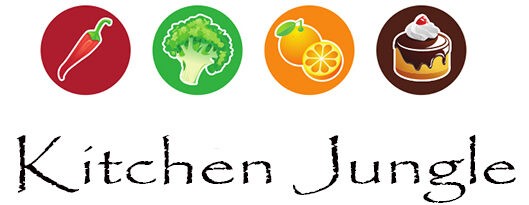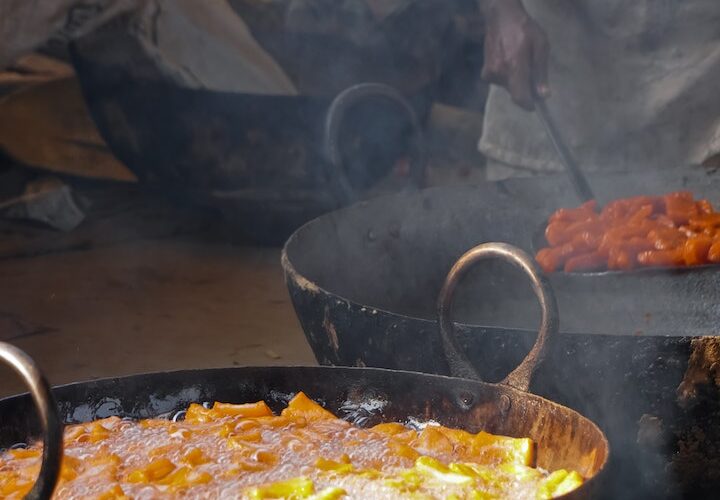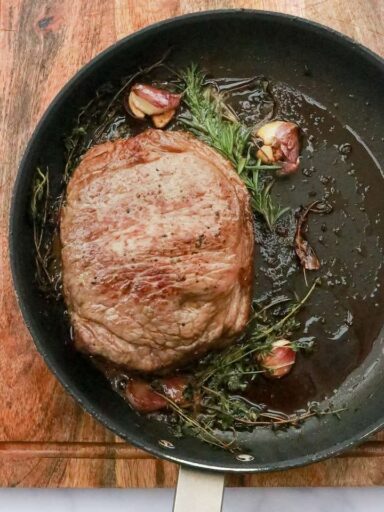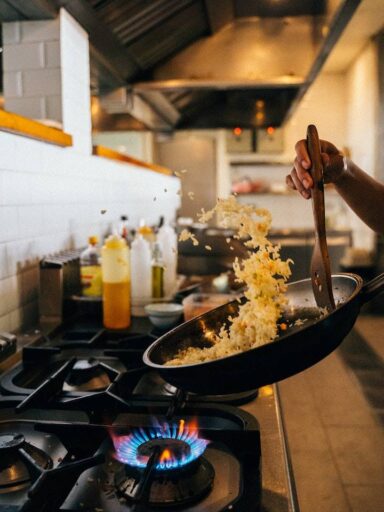Learn about the best pan for high-heat cooking and how to properly care for them in this detailed guide. Discover the benefits of cast iron, stainless steel, and carbon steel pans.
The Art of Cooking at High Heat: The Importance of Choosing the Right Pan
Cooking at high heat requires precision, skill, and a good understanding of the tools you need to use. Whether you’re searing a steak or stir-frying vegetables, cooking at high temperatures can be a challenge without the right equipment.
In order to achieve that perfect sear or crispiness, it’s essential to choose the right pan for high-heat cooking. In this article, we will discuss the different types of pans available and what to consider when choosing one for your needs.
Explanation of High Heat Cooking
High-heat cooking is a technique used in many recipes that involves cooking food at temperatures above 400 degrees Fahrenheit. This method is often used in dishes that require quick cooking times such as stir-fries, seared meats, and roasted vegetables.
When using this technique, it’s important to understand how different types of pans can affect your results. The goal of high-heat cooking is to create a crisp outer layer while keeping the inside moist and tender.
This process caramelizes sugars and browns proteins, creating complex flavors and textures that are unique to high-heat cooking. However, if you use the wrong pan or don’t regulate your temperature correctly, you risk burning or overcooking your food.
Importance of Choosing the Right Pan for High-Heat Cooking
Choosing the right pan for high-heat cooking is crucial because it affects how evenly your food cooks and how well it caramelizes on the outside. Different materials have different thermal properties which impact their performance when exposed to high temperatures. For example, cast iron skillets are great for high-heat cooking because they retain heat well and distribute it evenly across their surface area.
They also tend to develop coatings over time which makes them non-stick without any Teflon or other coatings. On the other hand, stainless steel pans are great for searing because they can handle high temperatures and are durable.
They also do not react with acidic ingredients like tomatoes or lemons. Choosing the right pan is just as important as choosing the right ingredients.
By understanding how different types of pans perform under high heat, you’ll be able to create dishes with complex flavors and textures that will impress your guests. In the next section, we will discuss the different types of pans available for high-heat cooking.
Types of Pans for High-Heat Cooking
Cooking at high heat requires using the right type of pan to ensure that you get the best results. The three types of pans that work best for high-heat cooking are cast iron, stainless steel, and carbon steel pans.
Cast Iron Skillet
A cast iron skillet is an ideal pan for high-heat cooking because it can withstand extremely high temperatures without warping or damaging the surface. Cast iron skillets have a thick base that distributes heat evenly across the pan.
It is also very versatile and can be used on stove tops, in ovens, or broilers. One of the main benefits of a cast iron skillet is its ability to retain heat.
Once preheated, it will stay hot longer than other types of pans, making it perfect for searing steaks or other meats. Another benefit of a cast iron skillet is its natural non-stick surface which develops over time with use and proper seasoning.
To properly season your cast iron skillet, start by washing it with hot water and mild soap (if necessary). Dry it thoroughly then apply a thin layer of vegetable oil all around the inside surface and on the bottom before heating it in an oven at 350°F for about an hour.
Afterward, let it cool down before wiping any excess oil off with a paper towel. Some tips when using your cast iron skillet are: always preheat your pan before cooking, avoid putting cold liquids into the hot pan, never soak your cast iron skillet as this may damage its non-stick surface, instead rinse immediately after use, dry thoroughly then apply some vegetable oil before storing in a dry place.
Stainless Steel Pan
Stainless steel pans are another popular choice when it comes to high-heat cooking as they do not react with acidic foods like tomatoes or citrus fruits which could cause more reactive pans like aluminum to corrode and become toxic over time. Stainless steel pans also have a thick base that distributes heat evenly. They’re perfect for searing or browning meats, making sauces, or stir-frying vegetables.
When choosing a stainless steel pan, look for one that has a thick bottom with multiple layers of metal to ensure even heating. It should also have sturdy handles that are securely attached.
A good quality stainless steel pan is durable and can last for years. Some tips when using your stainless steel pan are: preheat your pan before cooking, use enough oil to prevent food from sticking, avoid using high heat as it may cause food to burn or stick, and allow your food to develop a brown crust before flipping it over.
Carbon Steel Pan
Carbon steel pans possess similar benefits as cast iron and stainless steel pans while being much lighter in weight and highly reactive with foods. Once properly seasoned, carbon steel develops a natural non-stick surface which provides excellent heat resistance and quick temperature recovery times for precise cooking control. When seasoning your carbon steel pan, wash it with hot water and dry immediately with a paper towel then add some vegetable oil around the inside surface of the skillet.
Heat on the stovetop until the oil starts to smoke then wait till it’s cooled down before wiping any excess off with a paper towel. Some tips when using your carbon steel pan are: preheat the pan before adding any ingredients, avoid overcrowding the pan as this may lower the temperature too much, and carefully monitor food as it cooks since temperatures can change quickly in carbon-steel cookware.
Care and Maintenance of High Heat Pans
How to clean and maintain your pans after use.
After using your high-heat pan, it is essential to clean it properly to ensure that it lasts longer. Cast iron, stainless steel, and carbon steel pans are relatively easy to clean if you follow the right steps. First, make sure that you allow the pan to cool completely after cooking before cleaning it.
Once the pan has cooled down, use a soft sponge or cloth to remove any food residue from the pan. Avoid using a metal scrubber or anything abrasive as this could scratch the surface of your pan.
If there are stubborn stains on your high-heat pan that won’t come off with normal washing-up liquid, try soaking the pan in hot water for a few minutes before scrubbing it again. If there is any food stuck on the surface of your cast iron skillet or carbon steel pan, you can add some kosher salt and scrub gently with a non-abrasive sponge or cloth until it comes off.
Tips on storing your pans.
Proper storage of your high-heat cookware is essential for ensuring its longevity. Before storing cast iron skillets or carbon steel pans, make sure they are thoroughly dry to prevent rusting.
You can dry them by placing them over low heat on the stove until all moisture evaporates. When storing high-heat pans like cast irons or stainless steel in cabinets with other cookware, be cautious not to stack them as adding excessive weight will warp their shape over time.
For long-term storage of these types of cookware items, place a paper towel between each one before stacking them together on shelves which helps avoid scratches & dents on their surfaces. Overall proper maintenance is key when owning high-heat cookware for longevity so ensuring its cleanliness every time after usage and proper storage techniques will keep your cookware in excellent condition for years to come.
Conclusion
After considering all the options, it is clear that cast iron, stainless steel, and carbon steel pans are the best choices for high-heat cooking. Cast iron skillets are durable and can last for generations if properly cared for. Stainless steel pans are versatile and easy to clean, making them a great choice for everyday use.
Carbon steel pans offer the benefits of both cast iron and stainless steel and are especially ideal for dishes that require high heat. When choosing the right pan for high-heat cooking, consider the type of food you will be cooking.
For dishes that require searing or blackening, cast iron or carbon steel pans are recommended. For more delicate foods such as fish or eggs, a stainless steel pan may be more suitable.
Caring for your high-heat pan is essential to ensure it lasts a long time. Avoid soaking your pan in water as this can cause rusting on cast iron or discoloration on stainless steel.
Instead, clean your pan with hot water and soap immediately after use while it is still warm but not too hot to handle. Use a non-abrasive sponge or cloth to avoid scratching the surface of the pan.
By choosing one of these three types of pans and properly caring for it after each use, you can enjoy delicious meals with perfectly seared crusts every time. Invest in a quality high-heat pan today and elevate your cooking game!




